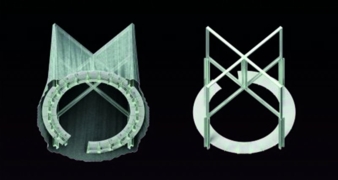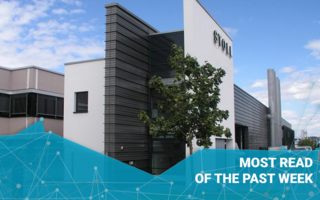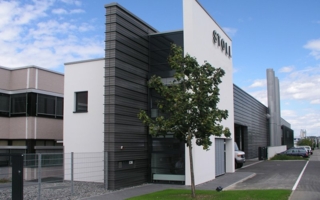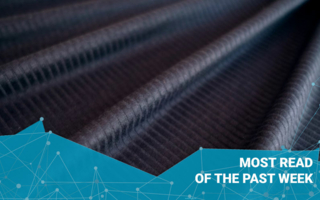04/02/2019 — auf Deutsch lesen
Flat knit in the Guggenheim Museum Bilbao
Stoll and the Guggenheim Museum Bilbao Collaborate in One of the Works Featured in “Architecture Effects Exhibition”.
Stoll, Germany’s leading 3D knitting machinery company, co-created and manufactured the textile element of “A Tent Without A Signal”, a digitally flat-bed knitted tapestry with technical content, as part of an exclusive collaboration with the Guggenheim Museum Bilbao in connection with its exhibition Architecture Effects – on view from December 5th, 2018 to April 28th, 2019.
The Guggenheim Museum Bilbao’s co-curators, Troy Conrad Therrien and Manuel Cirauqui, expressed that the exhibition’s purpose is to exemplify “the connections between art and architecture
at the height of unique 21st century conditions” by highlighting the impact technology has on a time of major digital transformations, social media, artificial intelligence, and climate change.
“Braided with metallic fibres, MOS’s tent doubles as a Faraday cage for the future, scrambling forthcoming 5G mobile signals,” says Therrien. “It embodies a nomadic typology but denies its traditional formless slack in favor of a taught lofting between two archetypal symbols in plan – the cross and the circle – by means of a digitally flat-bed knitted futuristically fluorescent tapestry, completed in collaboration with groundbreaking textile technology maker, Stoll.”
A Tent Without A Signal
A Tent Without A Signal, designed by MOS Architects, was uniquely made possible with STOLL machinery and knitting innovation due to the complexities and intricate details of this piece. The artwork was made with Stoll’s CMS 530 HP E16 and consisted of twenty-four 1m x 6m knitted panels. The five-colored jacquard with mesh pointelle panels were knitted with high tech Filati Be.Mi.Va, Pinori Filati, and Statex yarns.
“We are proud to collaborate with the Guggenheim Museum Bilbao for MOS’ project, A Tent Without A Signal. The Architecture Effects exhibition was a natural fit for us as our knitelligence platform, and
its various software solutions, continues to flourish in this Industry 4.0, digital age,” says Joerg Hartmann, Head of Fashion & Technology at Stoll. “There are so many capabilities of knitting that tend to go unnoticed, and we are very excited that the community can be witness to Stoll’s impact within the architecture industry.”
A case study of MOS’ A Tent Without A Signal and Stoll’s contribution will become available to the public and the contemporary artists and architects exhibiting as a part of Guggenheim Museum Bilbao
and Stoll’s technological collaboration.
MOS Architects
MOS is a New York-based architecture studio, founded by principals Michael Meredith and Hilary Sample in 2007. An internationally recognized architecture practice, MOS was the recipient of the 2015 Cooper Hewitt, Smithsonian Design Museum National Design Award in Architecture and the 2010 American Academy of Arts and Letters Architecture Award. Individual works have similarly received numerous awards and distinctions, most notably the 2015 Global Holcim Award or sustainable construction and the 2014 accession of the firm’s modular, off-grid Museum of Outdoor Arts Element House into the MoMA, Architecture and Design Collection. Recent work includes: House No. 10 (House with Courtyard), a recently completed residence in upstate New York; School No. 2, a competition proposal for a new Institute for Advanced Study Commons Building; and the Apan Housing Laboratory, a nine-acre master plan and Welcome Center in Hidalgo, Mexico. Recent and forthcoming publications, both products of and surveys on MOS's work, include Everything All at Once: The Software, Film, and Architecture of MOS (2013), MOS: Selected Works (2016), El Croquis No. 184 (2016), and An Unfinished Encyclopedia of Scale Figures Without Architecture (2019).
Guggenheim Museum Bilbao
When it opened in 1997, the Frank Gehry-designed Guggenheim Museum Bilbao – a spectacular structure made of titanium, glass, and limestone – was hailed as the most important building of its time. Located in the Basque city of Bilbao in northern Spain, the museum organizes temporary exhibitions as well as presentations from its Permanent Collection and other Guggenheim Collections.




